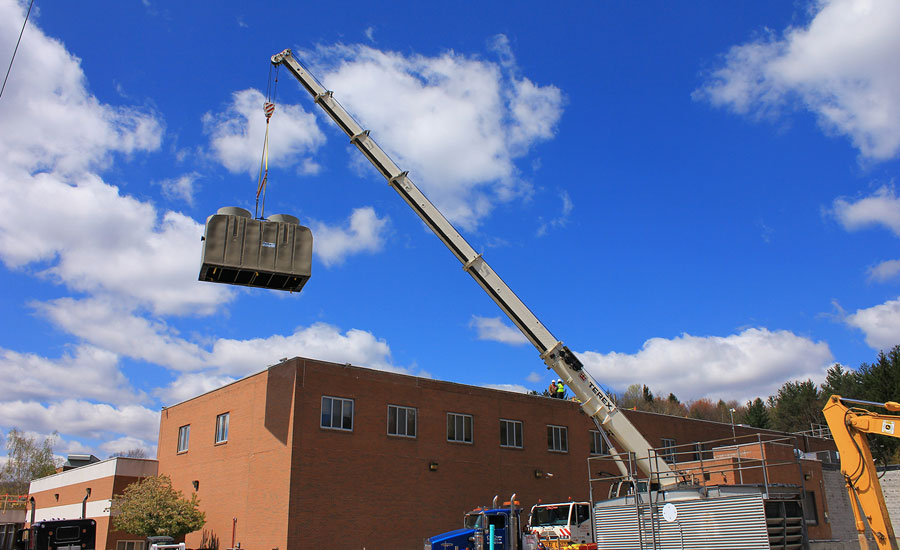Cooling towers are a relatively inexpensive and reliable way of expelling heat from a number of industrial and commercial processes, including nuclear & thermal power plants, petroleum refineries, petrochemical plants, food processing plants, as well as commercial HVAC systems.
As the worldwide market for these applications continues to grow, so does the need to address the issue: How large should a cooling tower be to efficiently handle a specific application.
“There are a lot of different applications where you certainly don’t want an undersized cooling tower,” said John Flaherty, president of Delta Cooling Towers. Delta manufactures a line of high-density polyethylene (HDPE) engineered plastic tower models.
“For example, if an undersized cooling tower is not producing cold enough water to cool the condenser loop of an office building’s HVAC chiller, then the chiller could shut down. That would probably mean some expensive repairs plus a lot of angry tenants.”
On the industrial side, Flaherty advises that insufficient tower cooling capacity can cause breakdowns or even severe damage to costly process equipment, resulting in extensive losses in productivity. In fact, determining the minimum size for most any application is critical.
Cooling towers are known, generally, for their ability to expel waste heat from an industrial process or the condenser in a comfort cooling application. Wet cooling towers achieve this function through evaporating a small portion of the recirculating water, resulting in significant cooling of the returning water to the process.
COOLING TOWER SIZING
For most wet cooling tower applications, said Flaherty, optimum cooling tower size may be determined by a combination of four different metrics: heat load, range, approach, and wet bulb temperature. In order to understand how these factors influence cooling tower size, it is first necessary to give the terms some context.
The wet bulb temperature (WBT) of the air entering the cooling tower is an independent variable that is a fundamental factor in dictating the appropriate size of a cooling tower. It is both the theoretical limit to the exiting cooled water temperature and the only specific air parameter necessary in cooling tower selection. In sizing a cooling tower, the highest WBT expected temperature is used for very hot, humid climates.
The thermal performance of mechanical draft towers is barely affected by relative humidity or by the dry bulb temperature (true thermodynamic temperature) of the entering air. For mechanical draft towers, the amount of mass airflow (generated by fans) constitutes much of the hot-water-cooling capacity of the tower.
Dry bulb temperature and relative humidity do have a major effect on the performance of natural draft towers, those without fans.
The difference between the WBT and the cooled water temperature is called the approach temperature (or simply, approach). Approach temperatures generally fall between 4° and 20°F. As the approach temperature drops, the required cooling tower size increases exponentially. However, many cooling tower manufacturers do not guarantee tower performance when approach temperature is less than 5°F.
The difference between the tower’s hot water temperature (water leaving the hot machinery) and the cold water temperature is called the range. Along with WBT and approach, the range also affects cooling tower size requirements. The heat load varies directly with range and gallons per minute (gpm) flow rate.
“When three of four sizing factors are held constant, the requirement for cooling tower size varies directly with heat load, but inversely with range, approach, and wet bulb temperature,” Flaherty explained. “So, there can be several design decisions to make that will impact the ultimate size of the required cooling tower.”
EFFICIENCY MATTERS
Flaherty noted that maintaining cooling tower efficiency is important to most applications.
An efficiency-related advantage of HDPE cooling towers is they are impervious to corrosion. The corrosives present in salt water air or the caustic atmosphere of many industrial sites are not a problem for these towers. Because HDPE towers are unaffected by corrosives, maintenance is minimized and service life increased.
Cooling tower efficiency can also be affected by tower footprint. “Some companies choose a tower with a smaller footprint to conserve on space,” Flaherty said. “But that may require using more power to drive the tower, and energy savings is high on a lot of companies’ priorities. So, in those cases, a cooling tower with a bigger footprint may consume much less energy, and therefore would be the more efficient choice.”
Flaherty added that for most industrial and commercial applications, it is highly beneficial to consult with an experienced cooling tower engineer before finalizing plans to purchase a tower for a facility.
For more information, visit www.deltacooling.com.
Publication date: 10/24/2016
Want more HVAC industry news and information? Join The NEWS on Facebook, Twitter, and LinkedIn today!


Report Abusive Comment